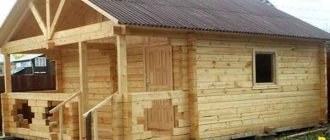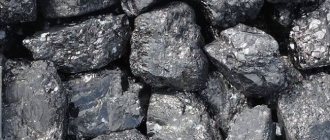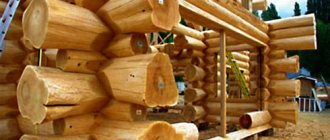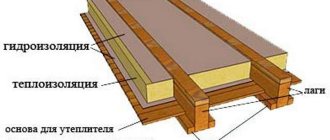The traditional Russian bathhouse is a wood-fired bathhouse, but progress does not stand still, and there are more and more gasified villages and villages, and firewood is becoming more and more expensive. And many are switching their bathhouses from wood to gas, but how justified is this? Website FirstStroy.ru will figure out which sauna is better, gas or wood, the advantages and disadvantages of both types of saunas.
Features and Specifications
Today, gas stoves have not only equaled wood-burning stoves in terms of their quality characteristics, but in many ways even surpass them. Gas sauna stoves are much simpler to operate, they operate cleaner, and the process of heating a sauna is cheaper than using wood.
In warm summer weather, such a stove warms up the air in the steam room in an average of 4 hours, but in winter it will take a little longer. To properly warm up the bathhouse, the stove should work for about 8 hours: this is a lot, however, the result will not be long in coming - a well-heated bathhouse can give maximum comfort, coziness and warmth to its visitors.
Gas is the cheapest and most economically consumed fuel, for the use of which you will not have to pay huge sums (unlike electric or traditional wood-burning analogues, the use of which will cost the consumer several times more). Increased attention and care is not necessary when operating such a stove: there is practically no combustible waste (ash, etc.) from the gas, which means that the firebox and smoke exhaust channels will only have to be cleaned once every few years.
The installation and use of a gas sauna stove must be in accordance with very strict rules, violation of which poses a high risk of explosion, gas leakage, and damage to people and property. However, if the rules are strictly followed, gas stoves for heating baths can last for almost a quarter of a century.
Preventive inspections and timely repairs can make such a stove a reliable source of heat, guaranteeing high-quality combustion and heat in the bathhouse! There can be only one requirement for installing a gas stove - the presence of a gas pipeline, because the cylinders will have to be changed too often.
Constructions
Gas furnaces generally have three main directions, they can be:
- household;
- heating;
- heating.
Gas sauna stoves are the second type of device (heating). The heating option is more intended for an autonomous heating system in the house and for hot water supply.
They are unable to maintain the required temperature at high humidity. The household class of devices is used for cooking and their main criterion is unpretentiousness and ease of operation, making them an indispensable assistant in the country.
In addition, gas sauna stoves are divided into groups according to the following criteria:
- material;
- burner type;
- Type of fuel;
- method of heating water.
Housing material
A stove for a gas bath can be made of stone or brick, it can also be made of metal. Each of these types of housing has pros and cons.
Stone and brick
Brick sauna stoves, although they take longer to heat up, but, unlike metal ones, retain heat much longer. In this regard, you have to start heating the steam room at night in order to steam to your heart's content during the day.
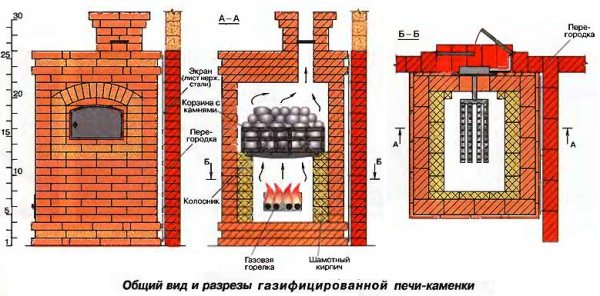
Gas fired brick stove
The appearance of this design is almost no different from a traditional wood-burning stove. Therefore, it can be built into a classic bathhouse without disturbing its harmony.
Only in this case, the “furnace” door provides access not to the place where firewood is loaded, but to the heater, which is located inside and is heated not only by the heat from gas combustion, but also by radiant energy.
Since it is placed directly above the burner, special requirements are placed on it. Bath stones should be placed in a metal trough, the bottom of which must have sides so that water does not fall on the flame.
Metal
Metal heater stoves have very thin body walls, as well as a small load of stones. Thanks to this, they warm up quickly, although they cool down just as quickly. Another advantage of the design is its compactness, which makes it possible to install the structure in any sauna or bathhouse.
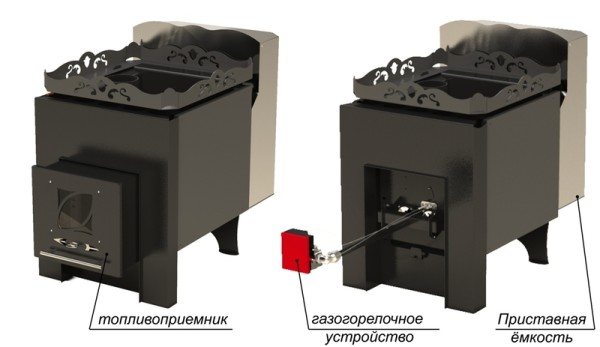
Metal stove-heater
Assembling a metal gas furnace is much cheaper. So, if you have the necessary skills and tools, you can make it yourself. Below are instructions for assembling the simplest version of a gas-powered sauna stove from a gas cylinder.
You will need:
- a used gas cylinder, which can be purchased at a scrap metal collection point for nominal money;
- a used wheel rim, which will become the base of the heater. You can buy it there;
- gas pipes: two Ø 2″ – will be used to supply air and gas to the chamber, one Ø 4″ – for the chimney;
- atmospheric gas burner;
- connecting elements.
Process
- Use a grinder to cut off the top of the gas cylinder so that a wheel rim can be inserted into the hole. It is better to weld them together using electric welding, but they can also be connected with bolts.
- Prepare the air supply pipe. Drill 8-10 holes Ø 5 mm in a 2-inch pipe. Also make a hole at the bottom of the cylinder with a diameter of 52-55 mm. The second, whole part of the pipe, should extend 150-200 mm from the cylinder. Secure it with electric welding.
- Installation of the gas supply pipe is also carried out. At the second end it is necessary to make an adapter to connect the structure to a gas cylinder or gas pipeline.
- Attach the chimney to the top of the cylinder and make a door by cutting out a rectangular hole with a grinder and attaching the hinges and handle to the resulting metal piece.
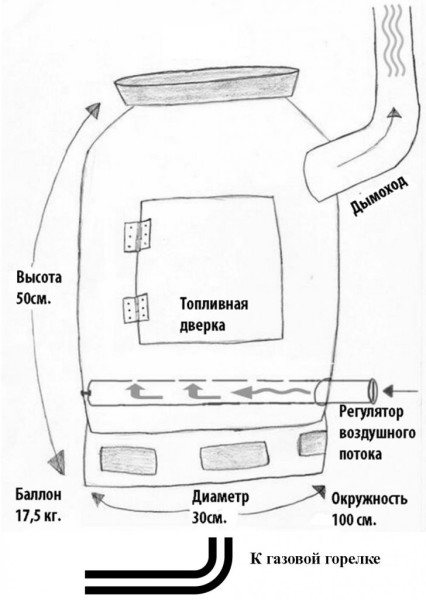
Scheme of a homemade stove from a gas cylinder
Classification by fuel type
Gas stoves can be either gas-only or combined (gas + wood), which are often called gas-wood stoves. But such versatility comes with additional costs when building a bathhouse, since the latter are large in size.
Therefore, the greatest demand today is for “clean” gas furnaces, which are more compact, lighter and safer to operate.
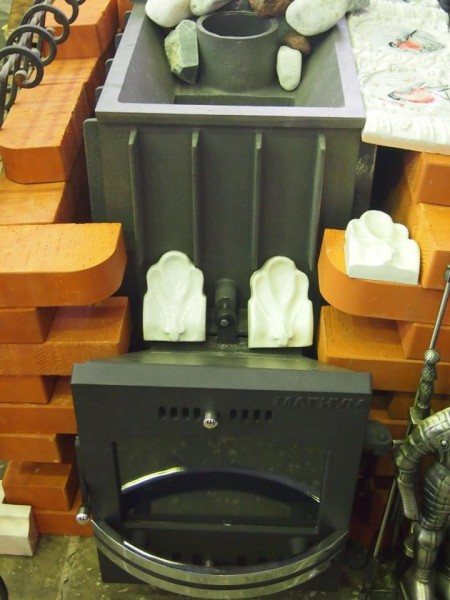
Gas wood stove
They can be connected not only to the central gas supply pipeline. The fuel can also be propane-butane, which can be purchased at regular car gas stations.
The latter is almost three times more powerful in terms of calorific value, so its consumption will be correspondingly lower. In addition, transportation and the possibility of storing fuel in liquefied form will facilitate the operation of these devices.
Tip: to save gas when using propane-butane, you need to replace the standard injector, which has a larger hole than necessary.
Flaws
To place gas cylinders, it is necessary to manufacture and install a special metal box in an area located at a safe distance from the bathhouse and the house. You can also place them in a strong container, which you then bury in the ground.
Burner types
There are two types of gas burners for saunas:
- Atmospheric - an inexpensive device, such a gas burner for a bath does not depend on the supply of electricity and does not require the installation of serious automation in furnaces. Air can enter the chamber through the ash door or special pipes. Therefore, the efficiency of a stove with such a burner greatly depends on its volume. If there is a lack of oxygen, combustion is not as intense, the gas is not completely burned and the efficiency of the device decreases.
- Superchargers are a complex device; they depend on electricity, since the design includes a special fan for pumping air. But, all this is compensated by the high efficiency of such furnaces. Pressurized burners are universal - they can be used in gas-burning stoves, but atmospheric burners are not suitable for this.
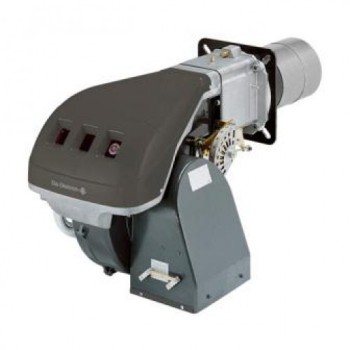
Pressurized burner
Water heating
Gas sauna stoves can also be used to heat water, not only to maintain the required temperature in the steam room. In this case, the energy of the combustion products, which are removed through the chimney of the bathhouse, and the radiant heat from the hot stones help.
A tank of water is installed directly above or below the heater, and a chimney is routed through the water. This design solution makes it possible not to increase the area of the device, and the stove takes up the same amount of space in the steam room as without a water tank.
Another option is to hang the tank on the side of the stove and on the back wall. The water is then heated by the metal body of the equipment.
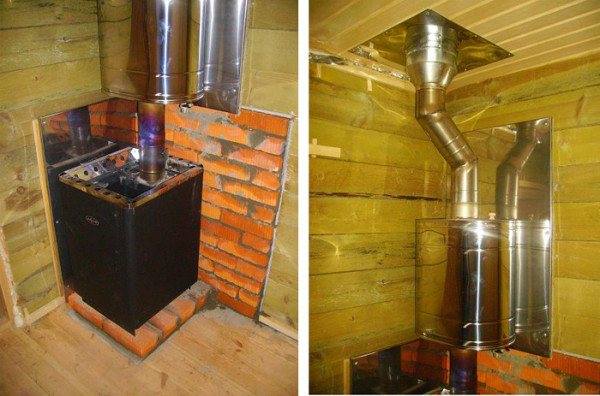
Gas oven with heating water tank
Carbon monoxide
This aspect is very important for a safe time in the bathhouse. The fact is that a person can become poisoned by carbon monoxide without noticing, especially when a certain dose of alcohol has been taken.
In order to protect yourself, it is necessary to install a carbon monoxide sensor for a bathhouse in the room, which will promptly notify you when a dangerous CO level has been reached in the atmosphere. Since this gas is heavier than air, the sensor should be installed closer to the floor.
Advantages of gas sauna stoves over other types
A traditional wood burning firebox is, of course, a great opportunity to create an atmosphere and warm up the steam room in the traditional way, but only if there is enough firewood for this. There is an alternative, and even more profitable - gas stoves for heating baths, which differ from other “sauna” counterparts in a number of the following advantages:
- Small parameters. The gas heater does not have a large firebox or ash pan, and the dimensions of its body are extremely small and do not take up much space even in the smallest steam rooms.
- Easy to select temperature. It is very easy to create the desired climate in the steam room - for this purpose, heating mode switches are installed on the heaters.
- Ease of operation - such a heater does not require serious care and a lot of attention due to the absence of the possibility of ash sedimentation or the appearance of coals.
Pros and cons of wood-fired baths
Connoisseurs and fans of Russian baths will say that only a wood-burning bathhouse can create a unique atmosphere, but for those who consider a bathhouse primarily a place where they can have a good steam and wash, they will say that they don’t care about all sorts of sacred things.
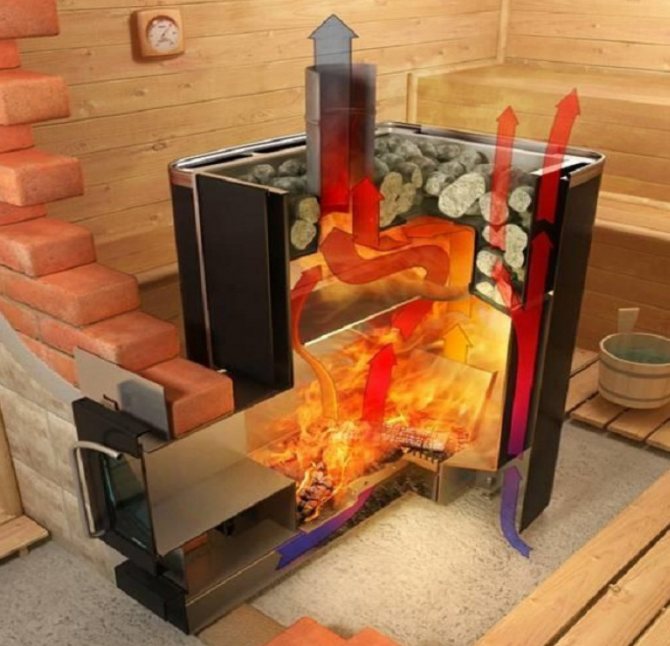
The second plus is autonomy, that is, if there is no gas in the village and no gas is expected, then a wood-burning bathhouse is the only option.
Third, it’s easier and cheaper to make a wood-burning sauna; stove equipment is cheaper, or you can even do it yourself. It’s more difficult with gas; firstly, you need to bring it to the bathhouse, bring it inside, and buy a stove with burners.
Perhaps these are all advantages.
There are many disadvantages: firewood is quite expensive, 10 thousand rubles per car, it still needs to be dragged to the woodshed, and each time the bathhouse is fired, it must be carried to the stove. For older people, this is still physical education.
Secondly, you need to clean the stove from ash after each kindling, and from time to time clean the chimney. We talked about how to clean a stove chimney here.
Third, kindling with wood takes a lot of time, you need to control the process and add more firewood.
Average prices on the market, model range
The compact Russian sauna stove "Urengoy" is made of heat-resistant alloy steel and is designed for heating a sauna room ranging in size from 6 m3 to 123 m. The stove weighs 35 kg and will cost its consumer 14 thousand rubles.

“Cascade” from the manufacturer “Teplodar” will heat a steam room with a volume of up to 18 cubic meters, and can additionally heat water. This stove is made of stainless steel, and for its consumer it will cost 19 thousand rubles.
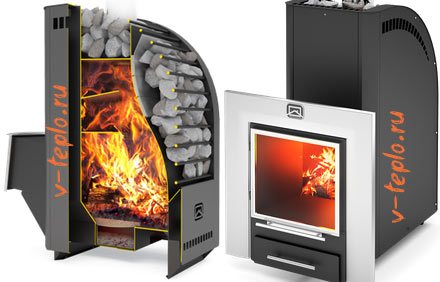
The cast-iron stove “Sudarushka M” will heat a room with a volume of up to 18 m3, and without taking into account re-equipment it will cost buyers 34 thousand rubles.
But one of the most powerful gas furnaces on the market, Kusaterm 90 kW, can heat up a really large steam room for a long time. The consumer will spend 110 thousand rubles on such a stove.
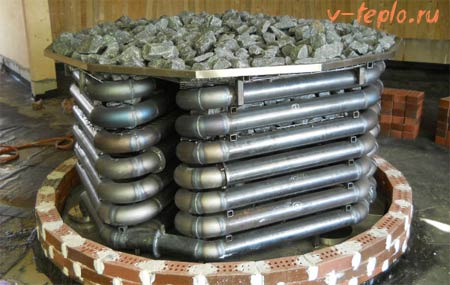
So, choosing a suitable gas stove is not difficult: the abundance of options on the market and knowledge about the characteristics of stoves will not allow you to make a mistake!
Furnace installation
Particular attention should be paid to the installation process; the safety and efficiency of work will depend on this.
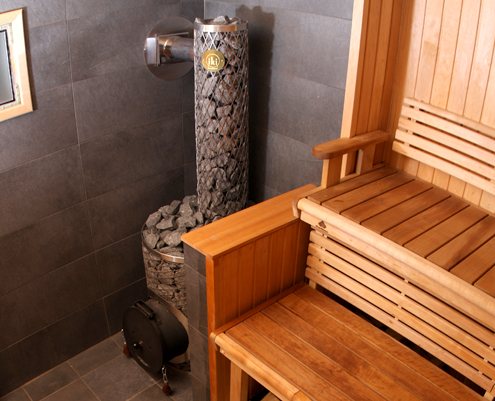
Fireproof protective screen
- If the wall is made of combustible materials, then the stove should be installed at least 50 cm away from it.
- Often, heat-resistant brick walls with tiling or ready-made screens are installed to protect against fire.
- Installation is done on a fireproof base, which should protrude 10 cm on each side.
- To create a chimney, stainless steel pipes are inserted into each other along the combustion path, at least half their diameter. You cannot lay them through living rooms. The height of the chimney above the burner level must be more than 5 meters.
- The chimney inside the bathhouse must be insulated with mineral wool to increase draft and protect against fires. All chimney joints must be sealed.
- The chimney does not have to exit through the ceilings and roof. You can make it exit through a hole in the wall.
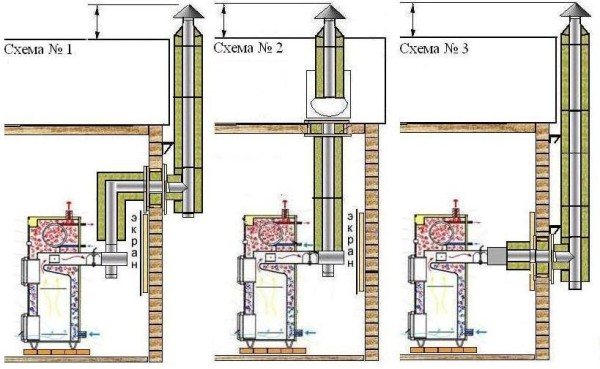
Chimney installation options
- Where the chimney passes through the ceiling, you need to make a fireproof ring with your own hands, for example, by pouring expanded clay into a metal box. A square sheet of fire-resistant material with sides of 30-60 cm is nailed around the pipe on the ceiling.
- The firebox should exit into the dressing room through a hole in the wall. If the walls are made of wood, you need to cut an opening in them and lay out a brick wall with a height and width of 70-90 cm.
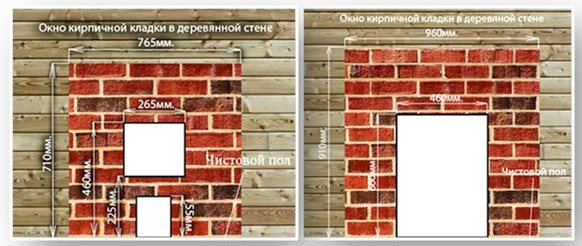
Example of an opening through a wall
- The ceiling height in the dressing room should be higher than 220 cm, in the upper zone there should be a hood and a window with a window.
- It is not recommended to attach the stove to walls and floors, or to mount brick walls close to it, as they will reduce convective heat transfer.
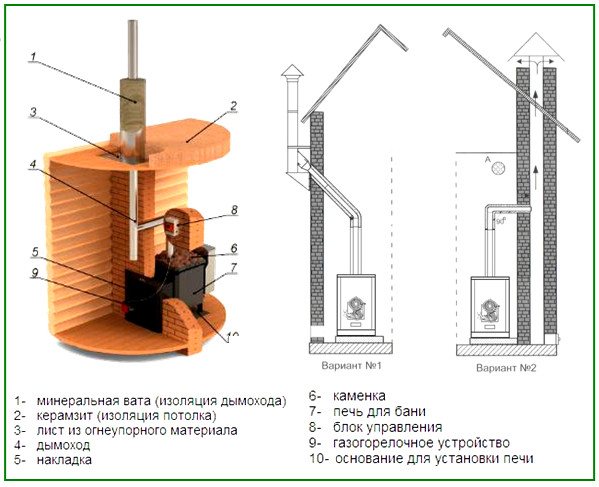
Furnace installation diagrams
The best manufacturers of sauna stoves
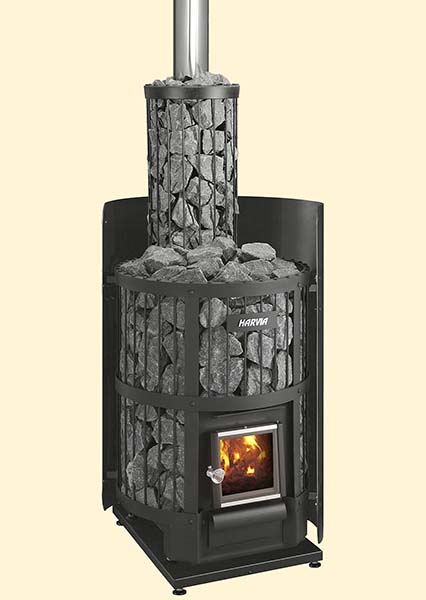
On the heating equipment market, the best heaters are those made in Europe, namely Finnish and Swedish. They are distinguished by high quality workmanship, thoughtful design, and beautiful design. This is not surprising, because it is in these countries that visiting a sauna is a cult. Of these, a large assortment includes the following brands: Harvia, Helo, Kastor.
Harvia stoves are popular in both wood-burning and electric units. They are known on the Russian market for many innovations. For example, electric models can be left in standby mode while the sauna is not being used. In this mode, the heater consumes 0.1 kW. After switching on at full power, a small steam room warms up in 40 minutes.
Harvia wood burning stoves are made of multi-layer steel. The firebox is available in 2 options: built-in or through the wall (loading of firewood occurs behind the wall of the steam room). The units are completely safe to use and have an ergonomic design. There are models with a tank for heating water, as well as with a heat exchanger.


